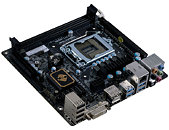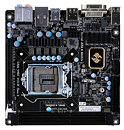Friday, September 26th 2014

ECS Announces the Z97I-DRONE and H97I-DRONE Mini-ITX Motherboards
ECS launched the Z97I-DRONE and H97I-DRONE mini-ITX, socket LGA1150 motherboards, which it first unveiled at Computex 2014. The two are identical to each other, with the only difference being the chipset. The Z97I-DRONE supports CPU and memory overclocking. Drawing power from a combination of 24-pin ATX and 8-pin EPS power connectors, the board features a 5-phase CPU VRM. The CPU socket is wired to a lone PCI-Express 3.0 x16 slot, and two full-length DDR3 DIMM slots. The only other expansion slot is an mPCIe 2.0 x1. Storage connectivity includes five SATA 6 Gb/s. Display connectivity includes one each of dual-link DVI, HDMI, and DisplayPort. Six USB 3.0 ports (four on the rear panel, two by headers), 8-channel HD audio with TOSLINK SPDIF output, and gigabit Ethernet make for the rest of them.


17 Comments on ECS Announces the Z97I-DRONE and H97I-DRONE Mini-ITX Motherboards
Very, very weird SATA port placement! Why did they smash em in the back of the motherboard?
That's gonna be a bitch to rout your cables to.
I guess that an M.2 Socket can be PCI-E ~OR~ Sata. (up to the manufacturer)
__________________________________________________________________________________________
Buying An M.2 SSD? How To Tell Which Is Which
ASUS GAMING MOTHERBOARDS | MAXIMUS MOTHERBOARDS | RAMPAGE MOTHERBOARDS · 07 APR, 2014 ·
21,905 VIEWS
· WRITTEN BY MARSHALLR ·
ROG HQ
M.2 (and SATA Express) are the future for SSDs, however there are different grades of SSD in terms of length and performance that need to be noted before buying. Certain keying on the M.2 SSD can help prevent mis-matching, but some motherboards only accept up to certain sized devices.
Please note: This article assumes that you have confirmed your motherboard/notebook supports PCI-Express M.2 SSDs, not SATA ones. Read our earlier guideto understand why this is important.
M.2 SSD Keying
Currently an M.2 SSD has either one of three key types: B, M or B+M, while a socket can only have one key. As the key positions of B and M are slightly different, the M. SSD can only be installed one way.
A ‘B’ keying (pins 12-19) gives PCI Express SSDs up to 2x lanes of bandwidth, while a ‘M’ keying (pins 59-66) provides PCI Express SSDs with up to 4x lanes of bandwidth. Even with 2x lanes of bandwidth a ‘B’ keyed M.2 SSD still gives 10Gbit/s performance, whereas the 4x lanes on ‘M’ gives up to 20Gbit/s. M.2 SSDs with B+M keying maximize compatibility in both slots, and will operate with 2x lanes of bandwidth.
M.2 SSD keying. Image courtesy of LSI
M.2 SSD Length
As the M.2 standard requires the SSDs (or, other types: WiFi, Bluetooth etc) only have chips on the upward facing side, this means that greater capacity drives are usually longer since they require more storage (NAND) chips. Generally there are up to five lengths of M.2, however not every motherboard or notebook can accommodate them all.
- 2230
- 2242
- 2260
- 2280
- 22110
The numbers are decoded as width-length, so for 2242, this is 22mm wide and 42mm long. The most common supported form factors are 2242 and 2280 (42mm and 80mm long). For example, the Maximus VI series with mPCIe Combo II card can support up to 2242 M.2 SSDs.M.2 SSD Buyers Checklist:
- Whether your motherboard/notebook supports M.2 SATA or M.2 PCI-Express (hint: check the specs page!)
- The type of keying (B/M/B+M) supported by the motherboard/notebook socket
- If it is PCI Express, whether it supports 2x or 4x PCI-Express
- The maximum length of SSD drive supported (2232 to 22110) (hint: it should say on the PCB)
SOURCE: LSI Blog▼ Related Articles
__________________________________________________
EXTREME EXPANSION
M.2 EXPENSION SOCKET FOR NGFF (NEXT GENERATION FORM FACTOR)
M.2 (NGFF) Interface
The latest evolution of M.2 Interface, known as NGFF (Next Generation Form Factor), provides a better and faster standard for Wifi/Bluetooth connection and expansion.